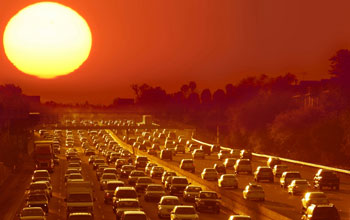 |
| In summer, extreme heat events are on the way in cities like Phoenix. Credit: NSF Central-Arizona Phoenix LTER Site |
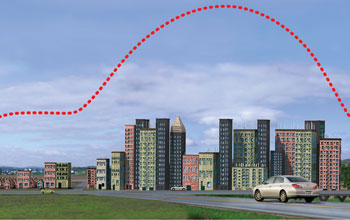 |
| The 'urban heat island effect' raises temperatures in cities compared with surrounding areas. Credit: NASA |
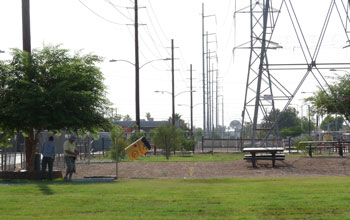 |
| Sherman Park, part of a low-income Phoenix neighborhood in need of green spaces. Credit: Sharon Harlan |
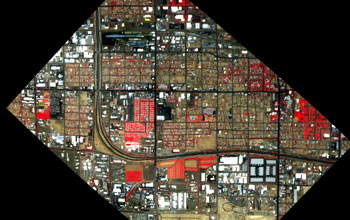 |
| Vegetation (red), soil (brown, tan), built materials (white) in a south Phoenix neighborhood. Credit: NASA |
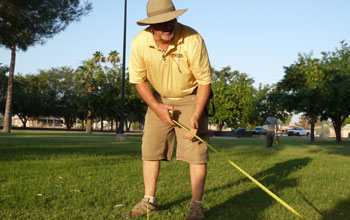 |
| Researchers Chris Martin, Darrel Jenerette (background) conducting field work in Phoenix. Credit: Sharon Harlan |
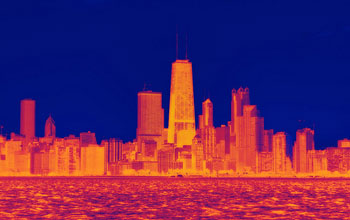 |
| Across the nation and around the world, urban areas are heating up. Credit: Dustin Phillips/Creative Commons |
The following is part ten in a series on the National Science
Foundation's Science, Engineering and Education for Sustainability
(SEES) investment. Visit parts one, two, three, four, five, six, seven, eight and nine in this series.
It's
the first day of summer, a hot time in the desert city of Phoenix. And
in cities across the United States--and the Northern Hemisphere.
Heat
islands, as these urban hot spots are called, are metropolitan areas
significantly warmer than surrounding rural areas. Why?
"Us,"
says sociologist Sharon Harlan of Arizona State University (ASU). "It's
all due to the effects of humans. We've modified the surface of the
land in ways that retain heat."
Urban heat islands are the
result. Soil and grass have been replaced with materials such as
asphalt and concrete that absorb heat during the day and re-radiate it
at night, causing higher temperatures.
Summer in a blistering desert
Harlan
and colleagues in fields across the social, natural and health sciences
are studying urban heat islands--and their opposites, park cool islands
where plant growth throws cold water on burning temperatures.
They're
conducting the research via a National Science Foundation (NSF) Coupled
Natural and Human Systems (CNH) grant. CNH is one of NSF's Science,
Engineering and Education for Sustainability, or SEES, programs.
"Cities
can be hot and uncomfortable places for the people who live in them,
with some populations especially vulnerable to health problems from
urban heat," says Sarah Ruth, CNH program director in NSF's Directorate
for Geosciences.
"The city environment and its human inhabitants
form a complex system with multiple connections. These researchers have
uncovered important information about this system and the interactions
among its components.
"The results suggest ways city officials
and residents can work together to create places where fewer people
suffer the effects of extreme temperatures."
The hot, arid
Sonoran Desert is central Arizona's natural environment. Humans have
transformed the desert over thousands of years, beginning with early
Native American subsistence farmers and continuing with late 19th
century Anglo-American commercial growers and 20th century sunbelt
migrants.
Metropolitan Phoenix is an ideal laboratory for
investigating heat-related human vulnerability, says Harlan. Rapid
urbanization has replaced natural vegetation and agricultural fields,
increasing summer temperatures during the past 50 years.
Islands of green
What's one of the answers? Park cool islands, found the scientists.
They evaluated the effects of plants' cool greenness on a Phoenix inner-city park.
The results were recently published in the journal Urban Ecosystems.
Along with Harlan, co-authors of the paper, all from ASU, are Juan
Declet-Barreto, Anthony Brazel, Chris Martin and Winston Chow.
They're
also working through the NSF Central Arizona-Phoenix Long-Term
Ecological Research (LTER) site, one of 26 such NSF LTER sites across
the nation and around the world.
"We predicted air and surface
temperatures under two different vegetation regimes: existing conditions
representative of Phoenix urban core neighborhoods, and a scenario
using principles of landscape design and architecture, and urban heat
island mitigation strategies," write the scientists.
They found that the air beneath and around "canopied vegetation"--trees--was cooler than the surroundings.
Larger
plants such as trees absorb and reflect the Sun's rays, buffering the
heat index. Scientists call it a "microclimate ecosystem service,"
better known as, simply, shade.
Trees also reduce hot air by
turning water from liquid to gas inside their leaves. "Temperatures
then fall in the immediate environment," says Martin.
It all adds
up to a park cool island. "Park cool islands are usually found in
irregular patterns in a city," Declet-Barreto says. "They're nested
within warmer spots."
The Latino Urban Core
The team studied the role of park cool islands in a low-income, ethnic minority community in inner-city Phoenix.
The
area is called the Latino Urban Core. It's bounded by industrial land
to the north, south and east and an interstate highway to the west. The
neighborhood's main feature is an electric utility company easement
currently used as "linear park space almost entirely devoid of
vegetation," states the Urban Ecosystems paper.
The
Latino Urban Core's sparse vegetation is mostly in residents' yards.
Patches of exposed soil with nothing growing on them are scattered
across vacant lots, yards, and the grounds of the "linear park."
Parks
in low-income neighborhoods tend to be hotter than parks in
higher-income areas, research has shown. Although residents in
low-income areas need places to cool off, these neighborhoods have less
inherent cooling capacity as there's less green space.
Inner-city
green space--lacking in Phoenix's Latino Urban Core--is a crucial
component of urban heat island mitigation, Declet-Barreto says. "But
it's made more difficult by ongoing debates over urban amenities like
parks and the needed resources, such as water, tax dollars, local
government will and regular maintenance."
"Ecologies of fear"
often arise in neglected green spaces. "They're legacies of
environmental and racial discrimination, inner-city decay and a
continuing urban planning focus on fringe [suburban] development," write
the researchers.
Studies have shown that in Phoenix, inner-city
areas bear higher property tax burdens in comparison with suburbs, but
the former receive significantly fewer tax dollars for parks, recreation
and water supplies.
Minority and low-income communities are
increasingly addressing such disparities by demanding a more equitable
distribution of urban amenities, such as green spaces like parks.
In
low-income communities, parks are often the only available public
gathering places. Green spaces, scientists say, can provide cultural,
social and--more directly applicable to extreme heat mitigation--human
health and ecological benefits.
Cooling down urban heat islands
Finding ways to offset National Science Foundation (NSF)high temperatures in desert cities where the weather is chronically hot, says Harlan, is critical.
Extreme
heat, scientists have found, is a threat to human health, increases
atmospheric pollutants and energy and water use, alters regional
hydrology and affects interactions between humans and ecological
processes.
"The problem of heat-related deaths and illnesses is
very serious," says Harlan. "Each year, heat fatalities in the U.S.
happen in greater numbers than mortality from any other type of weather
disaster." High heat wave events--unexpected and long-duration heat
waves--are becoming more common in cities like Phoenix, Chicago and
Paris.
Climate change and rapidly growing cities are likely to fuel more such events.
"Our
research suggests that climate intervention strategies should be
targeted at the neighborhoods and population groups that are most
vulnerable to environmental hazards like extreme heat events," says
Harlan. "We hope our results will be used in better decision-making
about climate adaptation in cities."
Greening parks is an
intervention strategy, she says, for urban heat island mitigation that
could be supported with public resources.
"If targeted to
low-income neighborhoods where vulnerability to heat is greater," says
Harlan, "it would address an environmental inequity and provide better
ecosystem services for these neighborhoods."
One antidote to an
urban heat island, it turns out, is another island, a place filled with
shade trees and lush growth: a park cool island.
| -- | Cheryl Dybas, NSF (703) 292-7734 | cdybas@nsf.gov |
Related Websites
NSF Science, Engineering and Education for Sustainability Programs:
NSF Science, Engineering and Education for Sustainability Programs:
http://www.nsf.gov/sees
NSF Publication: Discoveries in Sustainability:
NSF Publication: Discoveries in Sustainability:
http://www.nsf.gov/pubs/2012/disco12001/disco12001.pdf
NSF News Release: National Science Foundation Awards Grants for Research on Coupled Natural and Human Systems:
NSF News Release: National Science Foundation Awards Grants for Research on Coupled Natural and Human Systems:
The National Science Foundation (NSF).-
Guillermo Gonzalo Sánchez Achutegui
ayabaca@gmail.com
ayabaca@hotmail.com
ayabaca@yahoo.com
Inscríbete en el Foro del blog y participa : A Vuelo De Un Quinde - El Foro!

No hay comentarios:
Publicar un comentario